Heartfully Presented By
AIMS DARE TO SUCCESS
MADE IN INDIA
⏬Telegram Channel ⬇
https://t.me/AIMSDARETOSUCCESS
💡YouTube Channel 🔗
AIMS DARE TO SUCCESS
https://www.youtube.com/channel/UCm-y_cHY75scDiG67Df62dw?sub_confirmation=1
⌛ Web Sites ⏰
👀 For All Competitive Exams Study Material 👀
https://www.aimsdaretosuccess.blogspot.com
👇 For Mathematics Study Material 👇
https://www.aimsdts.blogspot.com
🔦 For Any Queries 🔭
aimsdaretosuccess@gmail.com
If u want to get FREE Study Material Please Add My number 9440345996 in Your All Groups
Joy of sharing is Caring & Helping
Important notes on Triangles and their Properties
Today we will be covering a very important topic from the Advance Maths part of the Quantitative Aptitude section that is – Important notes on Triangles and their Properties.
Triangles and their properties
Area of triangle
- When base and corresponding height is known: ½ * base * height = ½*c*h
- When all sides are given (Heron’s formulae): {s (s - a) (s - b) (s - c)}1/2 where, s = (a+b+c)/2
- When two sides and corresponding angle is given.: ½ a*c*sinθ
- When all the median are given (Median is a line joining the vertex to the opposite side at midpoint): 4/3 * {s(s – m1) (s – m2) (s –m3)}1/2
Note: Where, s = (m1+m2+m3)/2, m1,m2,m3 are three medians of the Triangle.
- When all the heights are given: 1/Area of ∆ = 4 {G (G – 1/h1) (G – 1/h2) (G – 1/h3),
Note: Where, G = ½ (1/h1 + 1/h2 + 1/h3)
Sine formulae of triangle
a/SinA = b/sinB = c/SinC = 2R Where, R is Circumradius
Cosine Formulae of triangle
CosA = b2 +c2 – a2 / 2bc
CosB= a2 +c2 – b2 / 2ac
CosC = b2 +a2 – c2 / 2ba
An interesting result based of cosine formulae
If in a triangle CosA = b2 +c2 – a2 / 2bc, Whereas b & c are the smaller sides then
Case I, b2 +c2 is greater than a2 then angle A is acute.
Case II, b2 +c2 is smaller than a2 then angle A is obtuse.
Case III, b2 +c2 is equals to a2 then angle A is Right Angle.
For example,
Ques: Find the type of the triangle ABC whose 3 sides are of length 11, 3 & 9.
Solution: Sum of square of two smaller sides is 32 + 92 = 9 + 81 = 90
Square of largest side is 112 = 121.
Hence, this triangle is obtuse angled triangle.
TRIANGLES AND ITS CERVICES
Medians of a Triangle
The medians of a triangle are line segments joining each vertex to the midpoint of the opposite side. The medians always intersect in a single point, called the centroid.
In the adjoining figure D, E, & F are midpoints of the side of the triangle while Line Segment AD, BE & CF are median. They are meeting at a common point I which is the centroid.
Properties:
- Centroid divides the Median in the ratio 2:1. i.e AI/ID = 2/1
- Apollonius Theoram:- To find the length of median when all sides are given: 4 * AD2 = 2(AC2 + AB2) – BC2
- All 3 median of a triangle divides the triangle in 6 equal parts.
i.e. ar of ∆AFI = ar of ∆AEI = ar of ∆BFI = ar of ∆BDI= ar of ∆CDI= ar of ∆CEI= ar of ∆ABC/6
Angle Bisectors
Angle bisectors are the line segment which bisects the internal angles of the triangle. All the three angle bisectors meet at a common point called as Incentre.
In the adjoining figure Line Segment A1T1, A2T2, & A3T3 are Angle Bisector. While point I is Incentre of the triangle.
Incentre is the only point from which we can draw a circle inside the triangle which will touch all the sides of the triangle at exactly one point & this circle has a special name known as Incircle. And the radius of this circle is known as Inradius.
Properties:
- Inradius = Area of ∆ A1A2A3 / Semi perimeter of ∆ A1A2A3
- Angle formed at the incentre by any two angle bisector: Angle A1IA3 = Angle A1A2A3 /2) + 90o
Perpendicular Bisectors of Sides of the Triangle
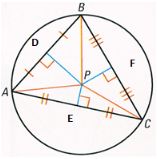
When the perpendicular bisectors of the side of the triangle is drawn they meet at a common point known as circumcentre.
This circumcentre is a special point as from this point we can draw a circle which will enclose the triangle in a way that all the vertex of the triangle lie on the circle. The radius of this circle is known as circumradius.
Properties:
In the adjoining figure DP, EP, & FP are perpendicular bisector of sides of the triangle. Point P is circumcentre.
- Circumradius = length of side AC * CB * BA / 4 * Area of triangle
- Angle formed at the circumcentre by any two linesegment joining circumcentre to the vertex: Angle APC = 2 * Angle ABC
Altitude of the Triangle
The orthocenter of a triangle is the point where the three altitudes meet. This point may be inside, outside, or on the triangle.
In the adjoining figure AD, BE, & CF are three altitudes of a triangle. And point O is the orthocenter.
Properties:
- Angle BOC + Angle BAC = 180o
SIMILAR TRIANGLE
If two triangles are similar, then the corresponding sides we have, shows the following relation:
- The ratio of sides of triangle is proportional to each other.
Like AB/DE = BC/EF = CA/FD
For example:
If AB = 6cm, BC = 10cm & DE = 2cm. Find EF
Solution: AB/DE = BC/EF, 6/2 = 10/EF, Therefore EF = 2*10/6 = 10/3
- The height, angle bisector, inradius & circumradius are proportional to the sides of triangle.
Median ∆ABC / Median ∆DEF = Height ∆ABC/ Height ∆DEF = AB/DE
- The areas of the triangles are proportional to the square of the sides of the corresponding triangle.
Area ∆ABC/ Area ∆DEF = (AB/DE) 2
For example:
If AB = 6cm, DE = 10cm & Area of ∆ABC is 135 sqcm. Find Area of ∆DEF.
Solution: Area ∆ABC/ Area ∆DEF = (AB/DE) 2
135/ Area ∆DEF = (6/10)2 , Area ∆DEF = 135*(5/3)2 = 375 sqcm.
In a right angled triangle, the triangles on each sides of the altitude drawn from the vertex of the right angle to the hypotenuse are similar to each other and to the parent triangle.
- ∆ ABC ≈ ∆ ABD
- ∆ ABC ≈ ∆ CBD
- ∆ DBC ≈ ∆ ABD
Proof: In ∆ ABC & ∆ ABD. Angle B and Angle D is 90o. & Angle A is common in both. Hence by AA rule Both triangles are similar.
Some Important Question are as follows::
(1)In the given figure  =?
=?
- 360°
- 720°
- 180°
- 300°
Ans. (a)
Here in triangle AEC
- 900°
- 720°
- 180°
- 540°
Ans. (c)
In star like figure we calculate the sum of angle by using formula (n-4) 180, when n is the number of point in the star.
(3) In the given figure below, if AD = CD = BC, and
(a) 320
(b) 840
(c) 640
(d) can't be determined
Ans. (c)
Here
(4)In the trapezium ABCD shown below, AD || BC and AB = 6, BC = 7, CD = 8, AD = 17, if sides AB and CD are extended to meet at E, find the measure of
(a) 1200
(b) 1000
(c) 800
(d) 900
Ans. (d)
(5)In the given figure, ABCD is a rhombus and AR = AB = BP, then the value of
is
(a) 600
(b) 900
(c) 1200
(d) 750
Ans. (b)
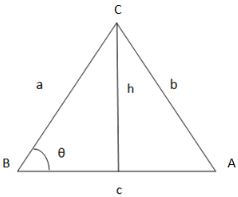
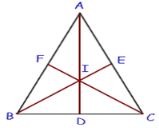
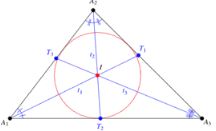

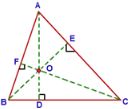
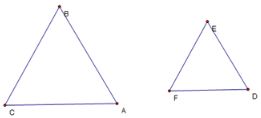
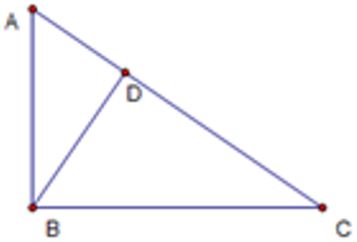
 =?
=?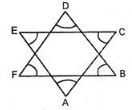
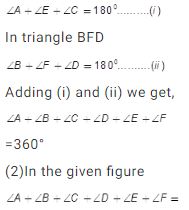
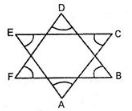
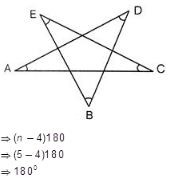


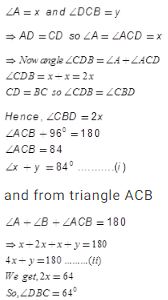

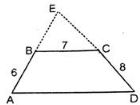
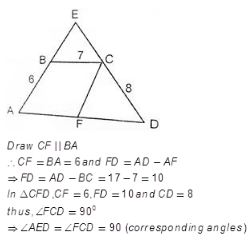

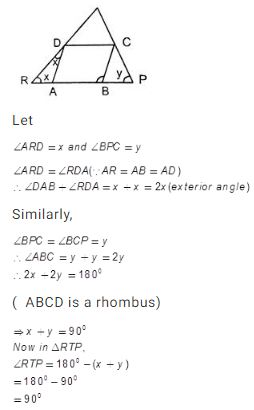
No comments:
Post a Comment